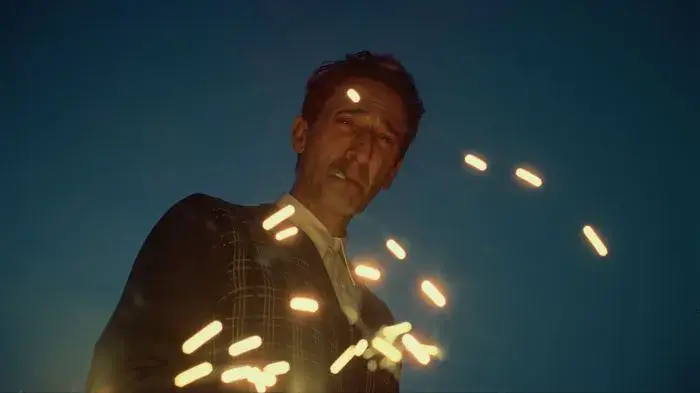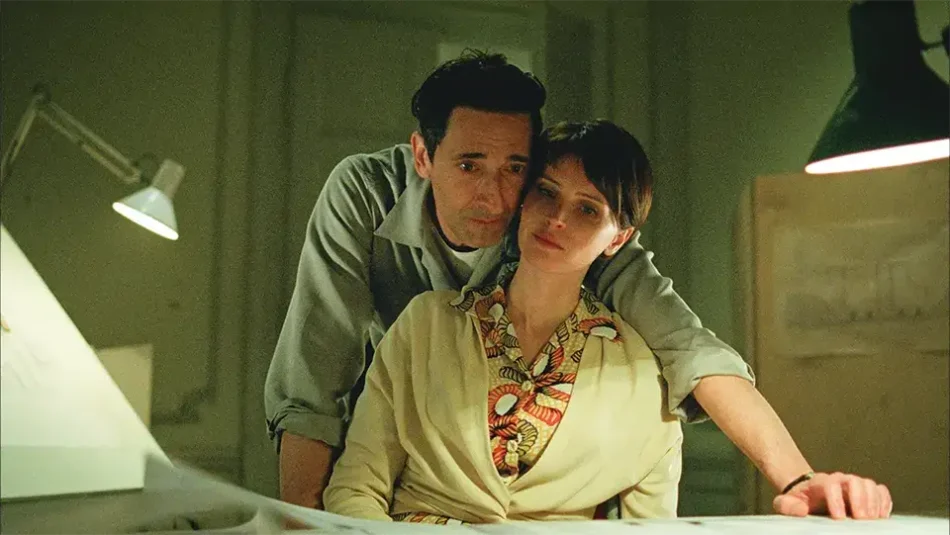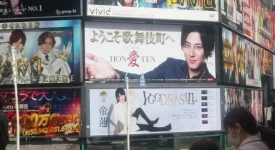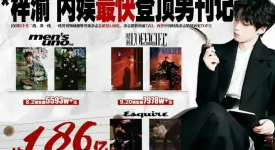(may contain spoilers)
Douban rating: 7.2
Director: Brady Corbet
Starring: Adrien Brody, Felicity Jones, Guy Pearce
Douban Comments: “Setting aside the exact meaning of ‘brutalist’, this film is a rare recent example that can be appreciated both for its technical mastery and performances – something you can sit down and watch quietly. Films that focus too much on technical prowess often fall into the trap of being hollow in content, or their visual beauty feels disconnected from the story’s rhythm. However, this film, with its well-structured narrative, epic length, and gradual introduction of main characters, perfectly matches the texture of 70mm film and the ambition of shooting entirely in VistaVision.
The soundtrack flows like a river, sometimes winding, sometimes surging, as if it were another character with something to say. Another crucial ‘character’ is the grand cathedral, built from the ground up, which at moments evokes the meta-cinematic feel of Herzog’s Fitzcarraldo.
In terms of performances, Adrien Brody and Guy Pearce deliver solid work, but they are not the whole story. Felicity Jones, who only fully appears in the second half, is equally impressive. The marriage of the Laszlo couple is not the film’s main focus, but Jones’ character plays a vital role – like the third leg of a triangle, bringing balance and stability to the film’s character dynamics.”

“The Brutalist has a somewhat dragged-out and detached narrative. The characters and generational themes feel somewhat abstract – while set in a specific time period and featuring particular ethnic backgrounds, the film doesn’t fully flesh out its characters’ inner worlds. For example, the protagonist’s determination, his devotion to family and the American Dream, and how that dream gradually crumbles lack key visual and auditory contrasts or hints for the audience. As someone without a refugee’s perspective, it was a bit harder to fully empathize.
That said, the cinematography, costume, and production design are truly outstanding. So many scenes were visually striking – pure technical mastery by the filmmakers. The triangular blocking in the coal mine scene was memorable, as was the long take following the actors during the Welcome to America sequence. The overexposed shot that revealed the Statue of Liberty in the sky was breathtaking – only film could capture that texture.
The production team was meticulous, even incorporating an intermission countdown directly onto the film reel. While the Alice Tully Hall screening was limited to 35mm, the director made a special effort to present a 70mm version at Walter Reade. If the pacing were a bit tighter and the dialogue more condensed, it would be near perfect. Initially, it felt a bit long, but the more I reflect on it, the more it lingers – I already want to watch it again.”
“The viewing experience is incredibly rich, with no concern for consistent style or smooth storytelling. Each scene starts fresh in a new format, forcing the viewer to constantly readjust; look away for a moment, and you’ll be left behind. At times it’s funny, at times tragic. Sometimes it focuses on performance and staging, sometimes on visual depth and composition. One moment it’s driven by dense, idea-packed dialogue, the next it’s all about the energy and emotion on a character’s face. It mixes stream-of-consciousness editing with bold, overpowering music in a way that feels wild and daring.
The themes are many but interconnected – Jewish exile and survival, the seductive and dark sides of the American Dream, the cracks and resilience in marriage. Even though the film is divided into clear sections, there’s no traditional plot structure to sum up. That actually fits the main character, whose work is always under construction – unfinished buildings in an unfinished city.
It’s been a long time since I saw a film this ambitious.”








